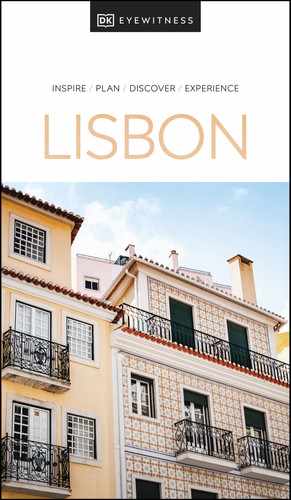experience more
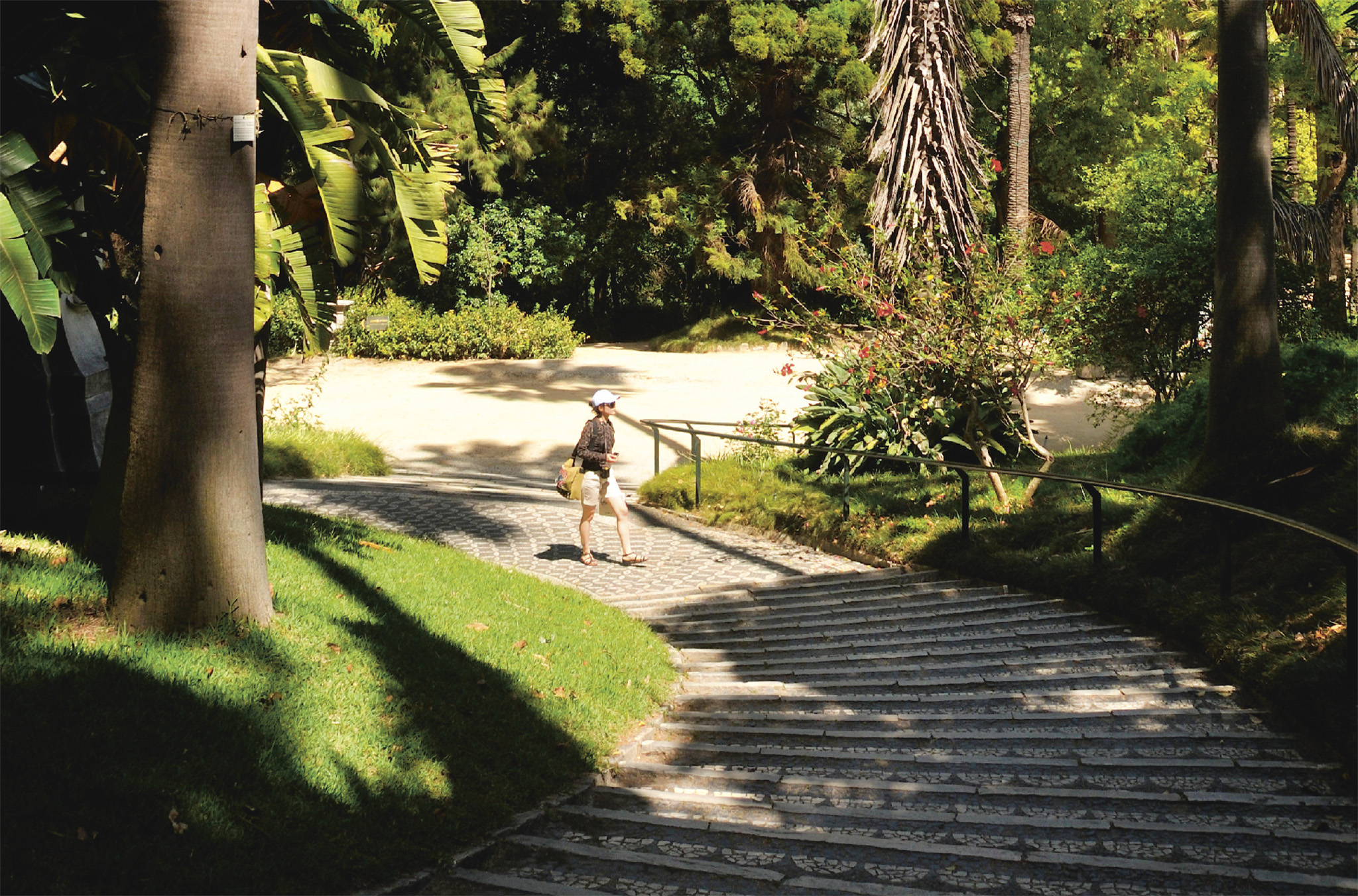
t Shaded path descending among exotic foliage, Jardim Botânico
This complex comprises a museum and 4 ha (10 acres) of gardens. The botanical gardens are well kept, and it is worth paying the entrance fee to wander among the exotic trees and dense paths as the gardens descend from the main entrance towards Rua da Alegria. A magnificent, verdant avenue of lofty palms connects the two levels.
The Museu Nacional de História Natural e da Ciência, or MUHNAC (National Museum of Natural History and Science), has collections on botany, zoology, anthropology, geology and palaeontology, as well as hosting temporary exhibitions on themes such as dinosaurs. The museum also exhibits scientific instruments dating from the 16th to the 20th century and holds popular, child-friendly programmes that demonstrate basic scientific principles.
Experience Baixa and Avenida
|
Stay Hotel Heritage Avenida Liberdade Tastefully converted mansion with slick decor and great views. M5 ⌂ Avenida da Liberdade 28 ∑ heritageavliberdade.com ¡¡¡ Hotel Almalusa Beautiful 18th-century building on a historic square. Many rooms have original features. N7 ⌂ Praça do Município 21 ∑ almalusahotels.com ¡¡¡ Inspira Santa Marta Eco-friendly hotel with contemporary feng-shui inspired decor. M4 ⌂ Rua de Santa Marta 48 ∑ inspirahotels.com ¡¡¡ |
This square, distinguished by its soaring obelisk erected in 1886, commemorates Portugal’s liberation from the Spanish yoke in 1640. The bronze figures on the pedestal depict Victory, holding a palm and a crown, and Freedom. The names and dates that are inscribed on the sides of the obelisk are those of the battles of the War of Restoration.
On the west side, the Palácio Foz now houses a tourist office and other businesses. It was built by Francesco Saverio Fabri in 1755–77 for the Marquês de Castelo-Melhor and renamed after the Marquês de Foz, who lived here in the 19th century. The smart Avenida Palace Hotel, on the southwest side of the square, was designed by José LuÍs Monteiro (1848–1942), who also built Rossio railway station.
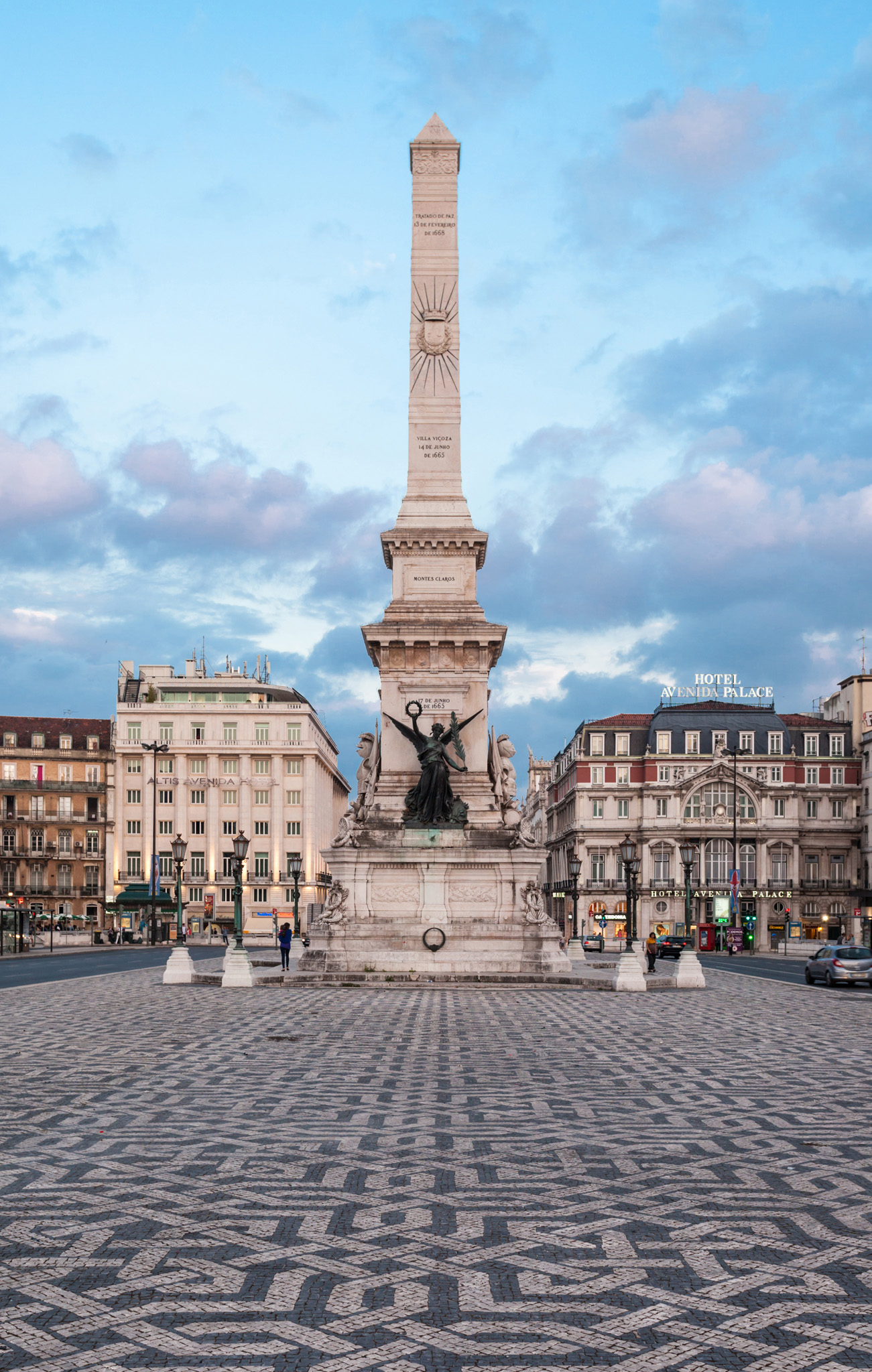
t The soaring obelisk dominating Praça dos Restauradores
After the earthquake of 1755, the Marquês de Pombal created the Passeio Público (public promenade) in the area now occupied by the lower part of Avenida da Liberdade and Praça dos Restauradores. Despite its name, enjoyment of the park was restricted to Lisbon’s high society and walls and gates ensured the exclusion of the lower classes. In 1821, when the Liberals came to power, the barriers were pulled down and the Avenida and square became open to all.
The Avenida da Liberdade you see today was built in 1879–82 to replicate the sophistication and style of the Champs-Elysées in Paris. The wide tree-lined avenue became a focus for pageants, festivities and demonstrations. A war memorial stands as a tribute to those who died in World War I. The avenue still retains a certain elegance, with fountains and café tables shaded by trees; however, it no longer makes for a peaceful stroll. The once majestic thoroughfare, 90 m (295 ft) wide and decorated with abstract pavement patterns, is now divided by seven lanes of traffic linking Praça dos Restauradores and Praça Marquês de Pombal to the north. Many of the Art Nouveau façades have given way to modern ones occupied by offices, hotels or shopping complexes, though some of the original mansions have been preserved. Look out for the Neo-Classical Tivoli theatre at No 188, with an original 1920s kiosk outside, and Casa Lambertini with its colourful mosaic decoration at No 166.
Did You Know?
Near Rossio is the Animatógrafo, one of Lisbon’s oldest cinemas. It still retains its Art Nouveau façade.
This little-known museum off the Avenida is in the former home of António Medeiros e Almeida, an industrialist who amassed an astonishing collection of international arts and crafts before bequeathing it to the nation in the 1970s.
Today the collection sprawls across 27 galleries – housed partly in Medeiros e Almeida’s 19th-century mansion and partly in a modern wing. It includes paintings by Rubens, Pieter Bruegel II and Jacob Huysman, with a self-portrait by Rembrandt as one of the highlights. Other notable items include a tea set that belonged to Napoleon, some of the earliest Chinese porcelain to reach Europe and a collection of ornate watches and clocks.

t Rossio, featuring wavy paving and a fountain
Experience Baixa and Avenida
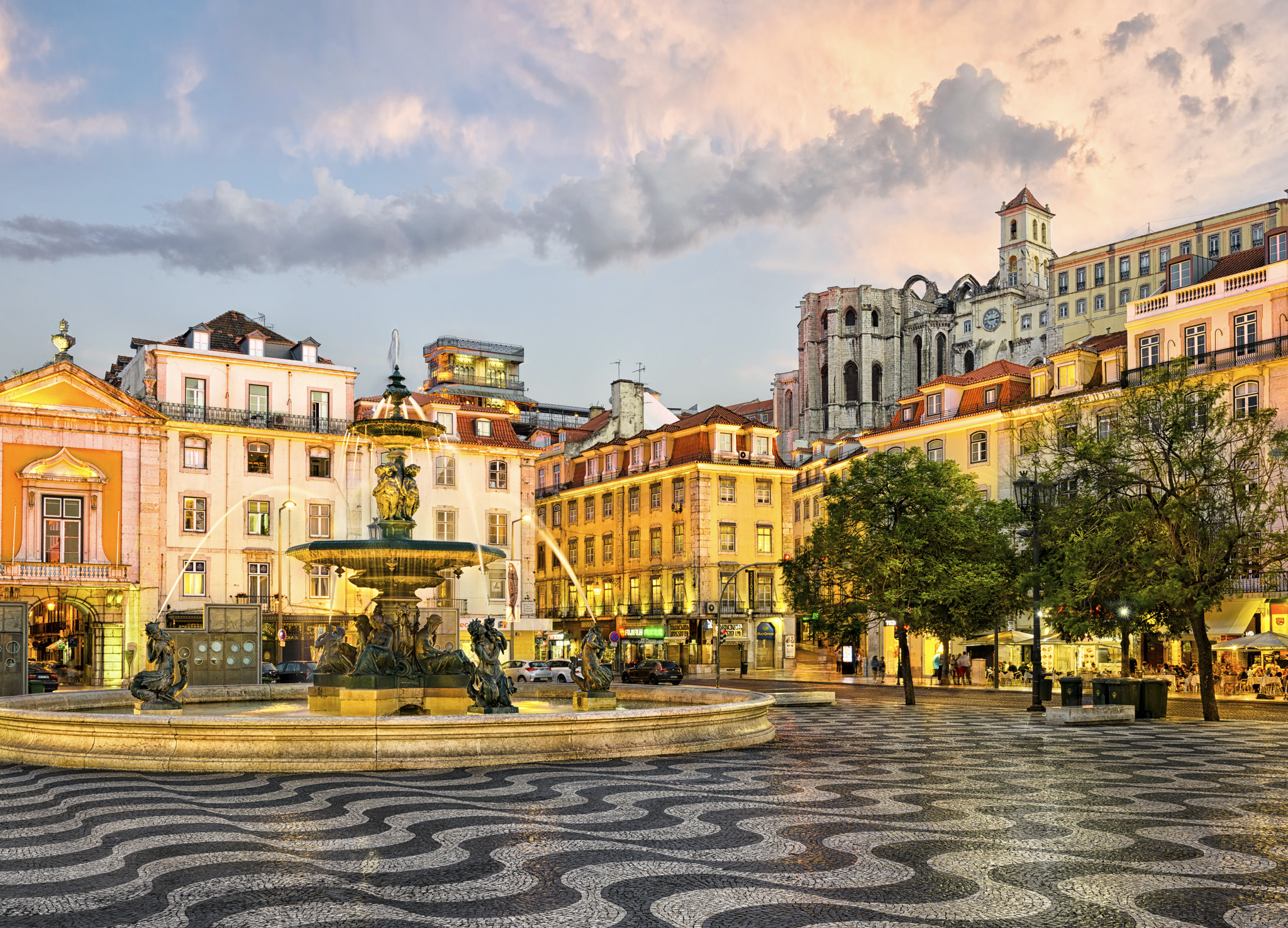
t Rossio’s dramatic central fountain at sunset
Formally called Praça Dom Pedro IV, this large square has been Lisbon’s nerve centre for six centuries: the stage of bullfights, festivals, military parades and gruesome autos da fé (acts of faith). The sober Pombaline buildings are now occupied by shops and cafés. Centre stage is a statue of Dom Pedro IV, the first emperor of independent Brazil.
In the mid-19th century, the square was paved with wave-patterned mosaics that gave it the nickname of “Rolling Motion Square”. The grey and white stone cubes were the first such designs to decorate the city’s pavements.
On the north side of Rossio is the Teatro Nacional Dona Maria II, named after Dom Pedro’s daughter. The Neo-Classical structure was built in the 1840s by the Italian architect Fortunato Lodi. The interior was destroyed by fire in 1964 and reconstructed in the 1970s. Atop the pediment is Gil Vicente (1465–1536), the founder of Portuguese theatre.
Café Nicola on the west side of the square was a favourite meeting place among writers, including the poet Manuel du Bocage (1765–1805), who was notorious for his satires.
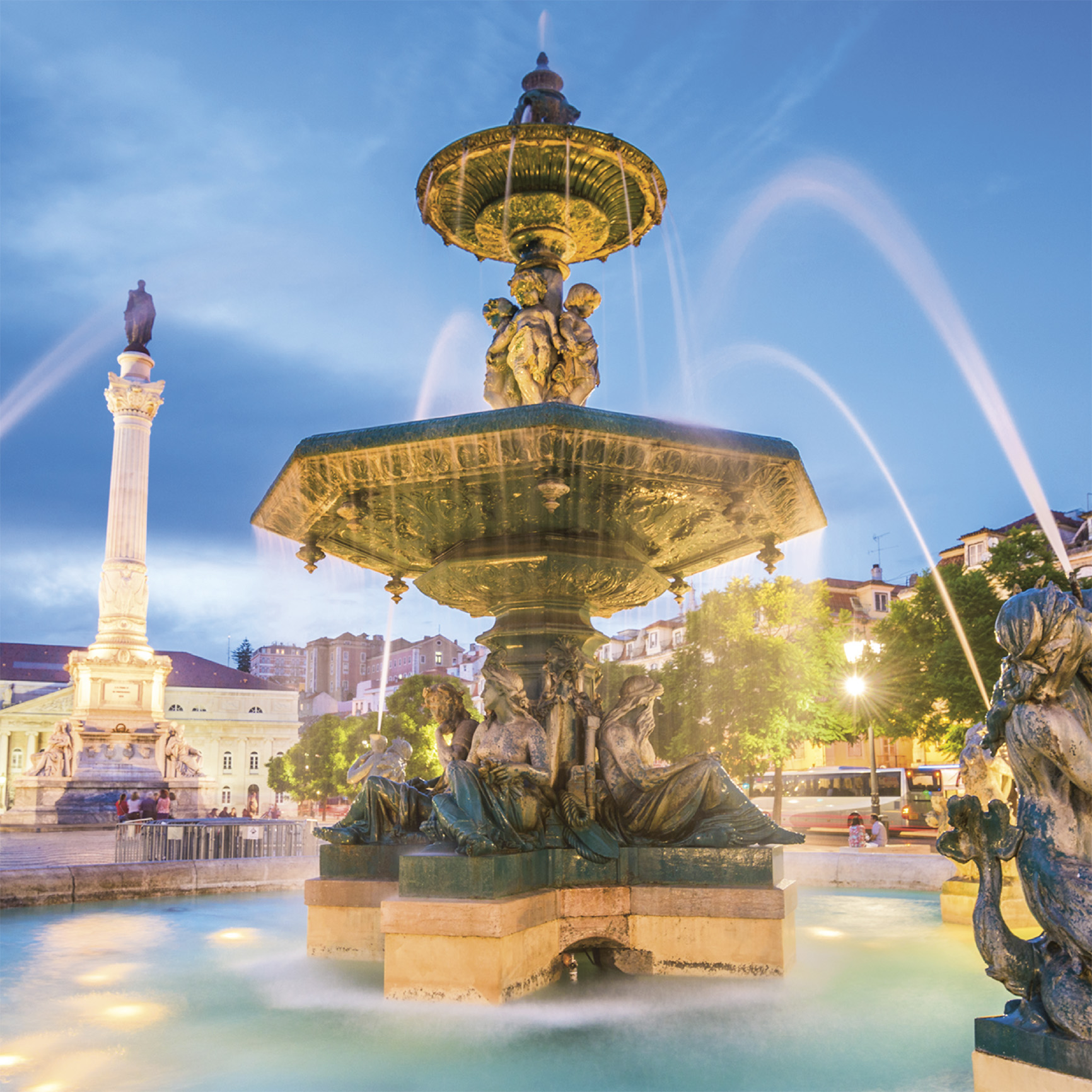
t That is illuminated at night
Experience Baixa and Avenida
|
Shop Manuel Tavares This 19th-century shop is partly a deli – selling local cheeses, nuts and preserves – and partly a wine store, with a large selection of port and Madeira wine. N6 ⌂ Rua da Betesga 1a ¢ Sun ∑ manueltavares.com Madeira House A traditional shop selling quality embroidery and linen from Madeira, as well as beautiful ceramics, decorative tiles and handicrafts from mainland Portugal. N7 ⌂ Rua Augusta 133 ∑ madeira-house.com |
A lively pedestrianized street decorated with mosaic pavements and lined with boutiques and cafés, Rua Augusta is the main tourist thoroughfare and the smartest in the Baixa. Street performers provide entertainment, while vendors sell souvenirs. The triumphal Arco da Rua Augusta, built to commemorate the city’s recovery from the earthquake, was completed only in 1873. There are great views from the top of the arch, which is accessed by an elevator.
The other main thoroughfares of the Baixa are Rua da Prata (silversmiths’ street) and Rua do Ouro or Rua Áurea (goldsmiths’ street). Cutting across these main streets are smaller streets that give glimpses up to the Bairro Alto to the west and Castelo de São Jorge to the east. Many streets retain shops that gave them their name: jewellers in Rua da Prata and Rua do Ouro and banks in Rua do Comércio.
In the heart of the Baixa is a small section of the Roman baths, located within the Banco Comercial Português in Rua dos Correeiros. The ruins and mosaics can be seen from the street window at the rear side of the bank; alternatively you can call on 211 131 682 and book ahead to visit the “museum”.
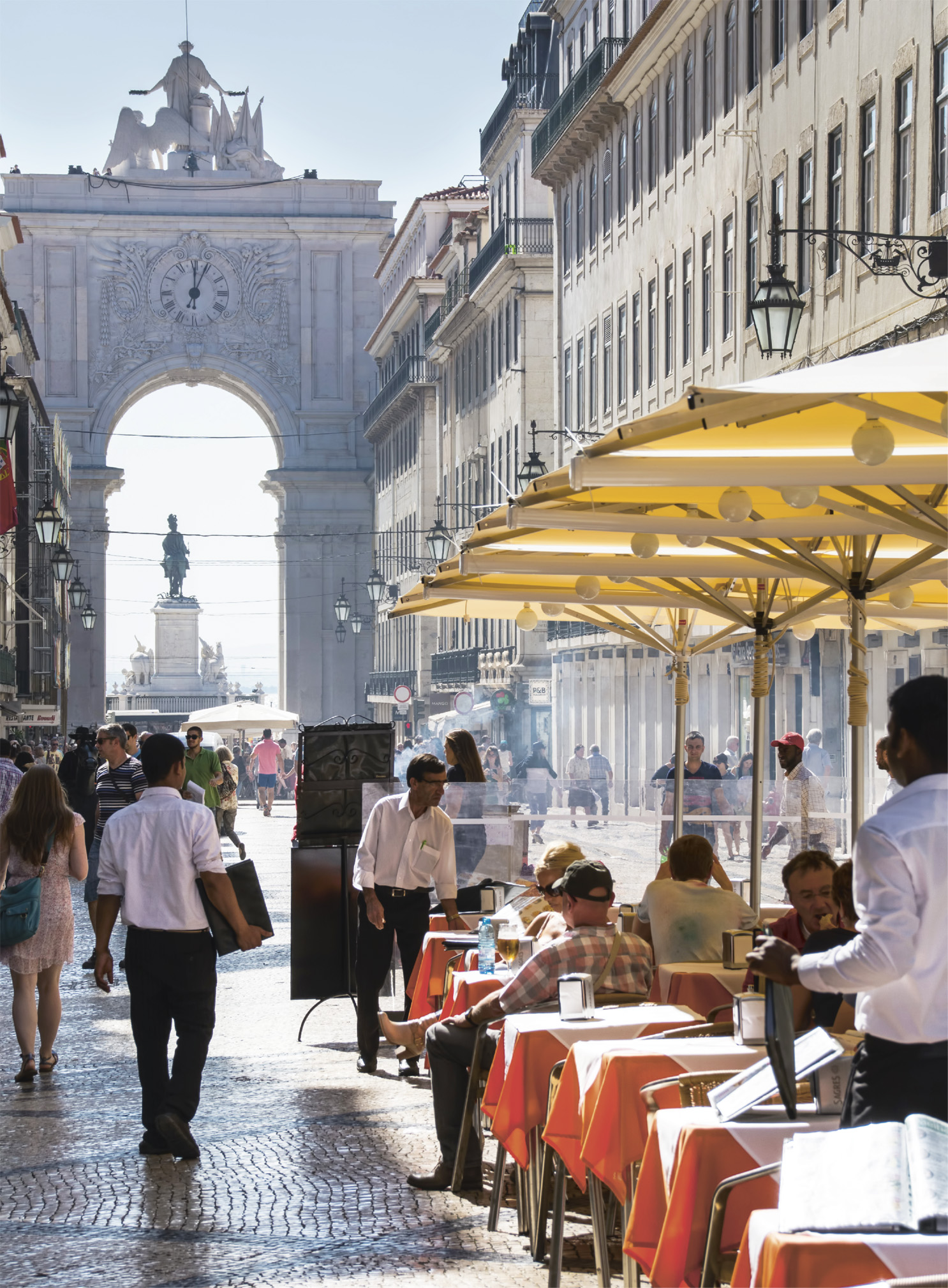
t Cafés lining the grand Rua Augusta, framed by the triumphal arch
Before the 1755 earthquake, the square next to Rossio was the site of the Hospital de Todos-os-Santos (All Saints). In Pombal’s new design for the Baixa, the square took on the role of the city’s central marketplace. In 1885 a covered market was built, but this was pulled down in the 1950s. Today, the four-storey buildings are given over to hotels, shops and cafés; the square is occasionally used as a marketplace. Perhaps its most eye-catching feature is the multitude of pigeons that perch on the pedestal supporting Leopoldo de Almeida’s bronze equestrian statue of João I, erected in 1971.

t Equestrian statue of João I standing in Praça da Figueira
Experience Baixa and Avenida
|
EAT Bonjardim, Rei dos Frangos Located on a side street, this is the ideal place to sample Portugal’s spit-roast chicken – with or without fiery piri-piri sauce. M6 ⌂ Travessa de Santo Antão 11–18 § 213 424 389 ¢ Wed in winter ¡¡¡ Cervejaria Ribadouro Set in a striking 1920s building, this bustling restaurant and brewery does a strong line in fresh seafood. M5 ⌂ Avenida da Liberdade 155 ∑ cervejariaribadouro.pt ¡¡¡ Confeitaria Nacional This historic café opened in 1829 and still serves a tempting array of pastries, teas and strong coffee. N6 ⌂ Praça da Figueira 18 § 213 424 470 ¡¡¡ |
Late-20th-century renovation works on this site uncovered archaeological finds, many dating back over 2,500 years. These have been preserved, often under glass flooring, and today can be visited in situ as part of a free and interesting guided tour. The cramped underground walkways provide a fascinating insight into Lisbon’s history, from pre-Roman times to the 18th century. Displays range from the remains of Roman fish-preserving tanks to wooden pillars used to prop up Baixa’s buildings when it was rebuilt on waterlogged land after the earthquake of 1755.
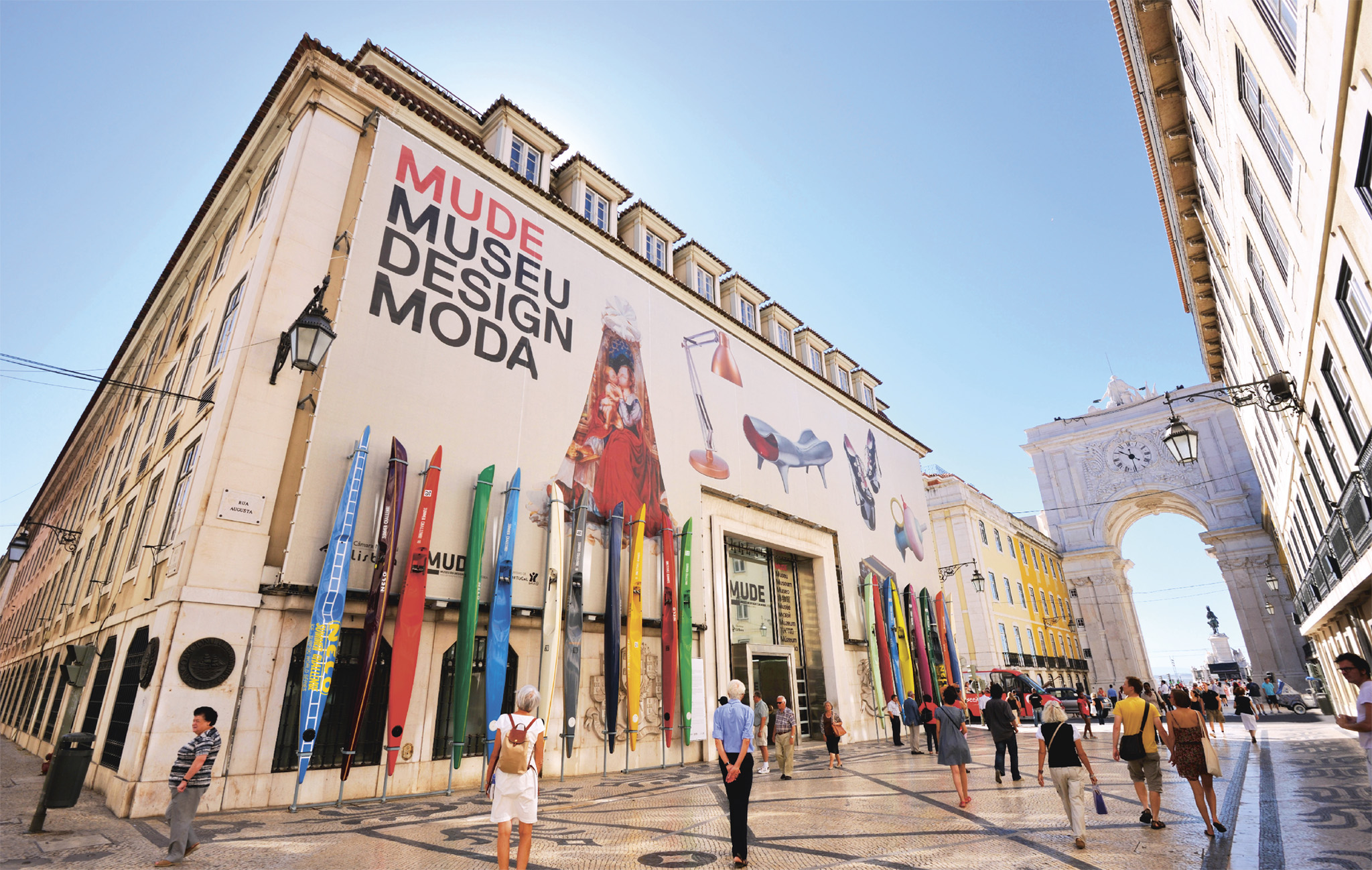
t MUDE, with the Arco da Rua Augusta in the background
Anyone with an interest in design or fashion will want to linger at this tremendous collection of 20th-century classics from around the world, which traces the evolution of design from the 1930s onwards. The bulk of the pieces on display are from the private collection of Francisco Capelo, which the wealthy economist bequeathed to the state in 2003.
Exhibits are overhauled regularly, but usually feature the likes of “Marilyn’s lips” (Bocca’s iconic mouth-shaped sofa), furniture by Philippe Starck or Charles and Ray Eames, and wonderful haute couture from Vivienne Westwood, Jean-Paul Gaultier and Alexander McQueen.
The elaborate Manueline doorway of the church is the only surviving feature from the original 16th-century Nossa Senhora da Misericórdia, which stood here until the 1755 earthquake. The portal is decorated with a profusion of Manueline detail, including angels, beasts, flowers and the cross of the Order of Christ. In the tympanum, the Virgin Mary spreads her protective mantle over various contemporary figures. These include Pope Leo X, Manuel I and his sister, Queen Leonor, widow of João II. It was Leonor who founded the original Misericórdia (alms house) on the site of a former synagogue.

Hidden Gem
Elevador do Lavra
Seek out the Elevador do Lavra, one of the city’s lesser-known street lifts located at the end of Largo da Anunciada. Dating back to 1884, it climbs up to the pretty Jardim do Torel gardens.
